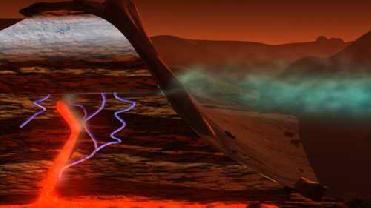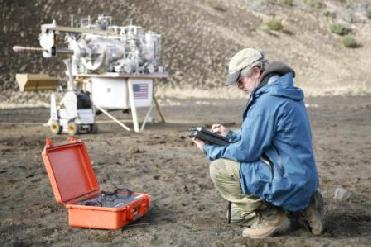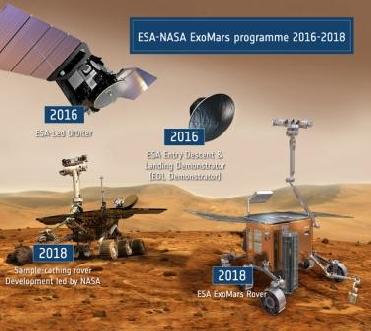
This artist's concept depicts subsurface water, carbon dioxide and the planet's internal heat combine to release methane. NASA photo
WASHINGTON (BNS): For quite sometime scientists have been trying to find traces of life on Mars. A look at the Red Planet indicates that is has been cold and dry for billions of years. The reason may be that the atmosphere is so thin that any liquid on the surface quickly evaporates because of the sun�s ultraviolet rays.
Research published in Science Express dated January 15, however, raises hope for Mars. The first definitive detection of methane in the atmosphere of Mars indicates that Mars is still alive, in either a biologic or geologic sense, according to a team of NASA and university scientists.
Lead author of the research, Michael Mumma of NASA�s Goddard Space Flight Center said that methane is quickly destroyed in the Martian atmosphere in a variety of ways.
�So our discovery of substantial plumes of methane in the northern hemisphere of Mars in 2003 indicates some ongoing process is releasing the gas. At northern mid-summer, methane is released at a rate comparable to that of the massive hydrocarbon seep at Coal Oil Point in Santa Barbara, California,� Mumma said.
The team found methane in the Martian atmosphere by carefully observing the planet throughout several Mars years with NASA's Infrared Telescope Facility and the W.M. Keck telescope, both at Mauna Kea, Hawaii. The team used spectrometers on the telescopes to spread the light into its component colours, as a prism separates white light into a rainbow. The team detected three spectral features called absorption lines that together are a definitive signature of methane.
One knows the existence of methane, four atoms of hydrogen bound to a carbon atom, as the main component of natural gas on Earth. It is of interest to astro-biologists because much of Earth�s methane comes from living organisms digesting their nutrients, like the cows who belch. However, scientists say life is not required to produce the gas. Other purely geological processes, like oxidation of iron, also release methane.
�Right now, we don�t have enough information to say if biology or geology, or both, is producing the methane on Mars. But it does tell us that the planet is still alive, at least in a geologic sense. It�s as if Mars is challenging us, saying, hey, find out what this means,� Mumma said.
NASA says if microscopic Martian life is producing the methane, it likely resides far below the surface, where it�s still warm enough for liquid water to exist. Liquid water, as well as energy sources and a supply of carbon, are necessary for all known forms of life.
�On Earth, micro-organisms thrive 2 to 3 km (about 1.2 to 1.9 miles) beneath the Witwatersrand basin of South Africa, where natural radioactivity splits water molecules into molecular hydrogen (H2) and oxygen (O). The organisms use the hydrogen for energy. It might be possible for similar organisms to survive for billions of years below the permafrost layer on Mars, where water is liquid, radiation supplies energy, and carbon dioxide provides carbon,� Mumma explained.
�Gases, like methane, accumulated in such underground zones might be released into the atmosphere if pores or fissures open during the warm seasons, connecting the deep zones to the atmosphere at crater walls or canyons,� he added.
Carl Pilcher, Director of the NASA Astrobiology Institute, said that microbes that produced methane from hydrogen and carbon dioxide were one of the earliest forms of life on Earth. �If life ever existed on Mars, it's reasonable to think that its metabolism might have involved making methane from Martian atmospheric carbon dioxide,� Pilcher said.
Geronimo Villanueva of the Catholic University of America in Washington, D.C, said that they observed and mapped multiple plumes of methane on Mars, one of which released about 19,000 metric tonnes of methane. �The plumes were emitted during the warmer seasons, spring and summer, perhaps because the permafrost blocking cracks and fissures vapourised, allowing methane to seep into the Martian air. Curiously, some plumes had water vapour while others did not,� Villanueva said.
According to the team, the plumes were seen over areas that show evidence of ancient ground ice or flowing water. Plumes appeared over the Martian northern hemisphere regions such as east of Arabia Terra, the Nili Fossae region, and the south-east quadrant of Syrtis Major, an ancient volcano about 745 miles across.
The Sun quoted John Murray, a member of the Mars Express European space probe team, as saying that the mini-Martians may be in a form of suspended animation and could even be revived. It said that Murray found overwhelming evidence of a vast frozen ocean beneath the dust near the Martian equator where simple life could have thrived as microbes.
London-based newspaper, The Sun said that Pillinger�s ill-fated Beagle 2 probe was carrying a laboratory that would have looked directly for such signs of life when it crashed on Christmas Day in 2003.
The paper said that NASA�s findings confirm studies by Europe�s Mars Express probe, which has been orbiting the planet for five years and also reported signs of methane in 2004.
Meanwhile, Britain�s top space expert Nick Pope hailed the new evidence of life as the most important discovery of all time. �What could be more profound than to know it is not just us out there,� Pope said.
�We�ve really only scratched the surface, it�s an absolute certainty that there is life out there and we are not alone. If there is life on Mars then the logical conclusion is that there must be life elsewhere too. If it�s happened here on Earth, then why shouldn�t it happen anywhere? The implication is this is a universal law. Mars is very similar to Earth. It�s about the same size, it�s a rocky inner planet,� he said.
�Most scientists believe it probably has liquid water which is almost universally agreed as the pre-requisite for life. I am certain there is other life in the Universe and, most likely, intelligent life,� he was quoted by The Sun.














The Indian Air Force, in its flight trials evaluation report submitted before the Defence Ministry l..
view articleAn insight into the Medium Multi-Role Combat Aircraft competition...
view articleSky enthusiasts can now spot the International Space Station (ISS) commanded by Indian-American astr..
view article